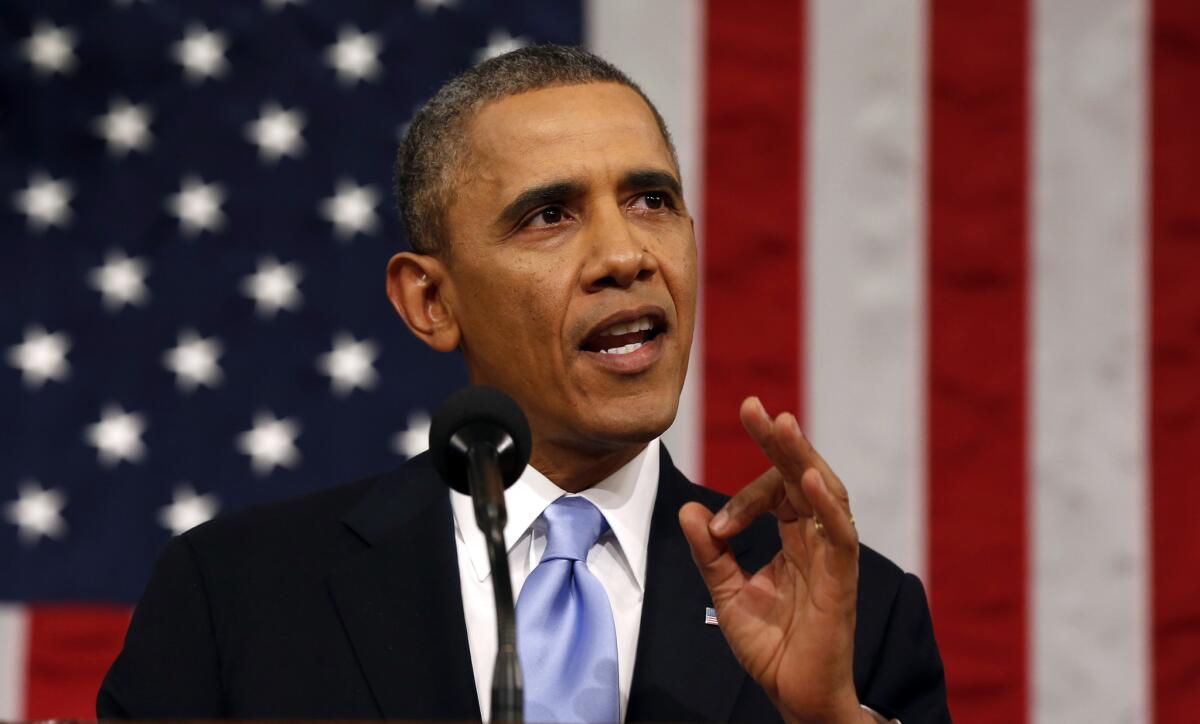State of the Union: Obama’s era of limits

- Share via
The rap against President Obama’s State of the Union address on Tuesday was that his agenda, once ambitious and transformational, has suddenly turned modest.
Instead of grand bargains and sweeping change, the president proposed holding a summit meeting on working families and extracting a promise from colleges to admit more low-income students — not exactly sweeping solutions to middle-class stagnation and college debt.
What happened to the visionary politician who promised that his inauguration would mark the moment the rise of the oceans began to slow?
PHOTOS: How the Democrats can win back the House and keep the Senate -- in 6 steps
Simple: Reality has sunk in.
In year six of Obama’s presidency, modest proposals are the most appropriate offering. At the moment, the president has much to be modest about — and no real alternative.
Any ability Obama might have had to navigate Washington’s poisonous political culture to forge consensus on sweeping initiatives vanished when Republicans took over the House of Representatives in 2010.
And the president’s sway has ebbed even further since his reelection in 2012, thanks to the chaotic launch of his health insurance program and the economy’s stubborn failure to produce enough new jobs.
With Obama’s job-approval rating stuck well below 50%, Republicans in Congress see plenty of reasons to oppose him but only danger in helping him.
Obama still has big goals, of course, which he listed in his speech: immigration reform, early childhood education, infrastructure spending, raising the minimum wage, even the lost cause of gun control. But he listed all of those in his speech last year — and achieved none of them.
That’s why the president’s embrace of things he can do without Congress makes sense. Expect to see more executive orders, more White House summits and more private sector arm-twisting.
Obama’s chief image maker, Dan Pfeiffer, deployed two phrases to dramatize this new strategy. The president “has a pen,” he said, meaning the power to issue executive orders, and he “has a phone,” meaning the ability to persuade corporate CEOs, college presidents and others to do the right thing.
This will be “a year of action,” Pfeiffer added — as opposed, presumably, to a year of stalled initiatives on Capitol Hill.
Obama offered insight into how he has accepted his newfound limits in a recent interview with David Remnick of the New Yorker.
“We cannot remake the world entirely during this little stretch that we have,” the president said. “At the end of the day, we’re part of a long-running story. We just try to get our paragraph right.”
That doesn’t mean he’ll quit trying, and bipartisan legislation on one big issue might still be possible: immigration reform. House Speaker John A. Boehner (R-Ohio) has said he wants to try to pass a series of immigration bills this year, and Obama says he’s willing to make a deal.
But expect downsized ambition to be the order of the day. Obama might still like to see a federal minimum wage of $10.10 an hour. But because that seems unlikely to pass the Republican House, it looks as if he’ll have to settle for the far more modest change he announced Tuesday: raising the minimum wage by executive order to $10.10 for federal contract workers.
That may be frustrating for a president who lamented in his speech that “corporate profits and stock prices have rarely been higher, and those at the top have never done better. But average wages have barely budged. Inequality has deepened. Upward mobility has stalled.
“Our job is to reverse these trends,” he declared.
But failing in that, as he seems likely to do, the president promised Tuesday to look for incremental ways to chip away at the gap between rich and poor.
And he will console himself with earlier victories. Already, at the White House, there’s a sense that the main work of the Obama administration is mostly complete.
“If you look at the whole eight years … the biggest and most important thing is coming back from the brink of economic disaster,” one of Obama’s aides told me this week. “And then healthcare. Those are the biggest changes we will see if we look back 10 years from now.
“Immigration will fall into that category, if we get it,” the aide added. But other priorities such as preschool education and job training programs aren’t likely to grow beyond a few micro-initiatives.
Still, if Obama can make his healthcare program work, avoid new economic or international problems and help his party retain control of the Senate — no small tasks — he’ll count 2014 as a success.
So yes, it’s a modest agenda. But gauged by what’s doable in the second term of an eight-year presidency, it is also a realistic one.
Twitter: @DoyleMcManus
More to Read
A cure for the common opinion
Get thought-provoking perspectives with our weekly newsletter.
You may occasionally receive promotional content from the Los Angeles Times.











